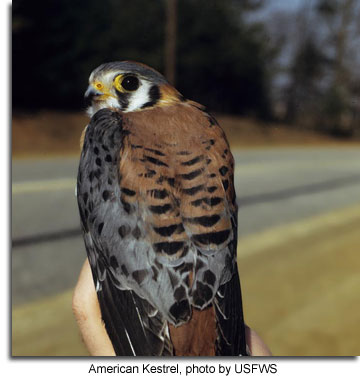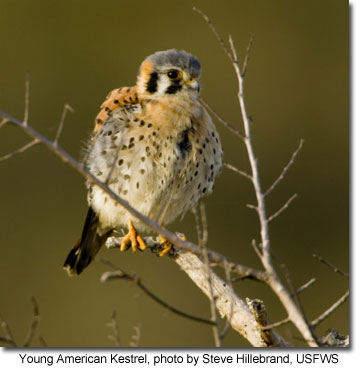Drive along any country road and you are bound to spot an American Kestrel perched on a power line, watching and waiting for its next meal. Often called "sparrow hawk", this little bird of the raptor family is actually a falcon and is closely related to the Peregrine Falcon.
What Does a Kestrel Look Like?
Kestrel males sport beautiful blue-gray wings, a rusty back and tail with a black terminal band, and black "whiskers" below each eye. Females have a rusty back, tail, and wings, all marked with black barring. The tops of their heads are blue with a rusty cap. Usually, the males have brighter colors than the females. Like other falcons, kestrels have long, pointed wings and an elongated tail to allow them to maneuver easily in the sky. American Kestrels are the smallest falcons found in North America with sizes similar to that of a blackbird. Despite their size and colorful markings, American Kestrels are fierce predators.

Natural History
The American Kestrel is Maryland's most common falcon. Kestrels are common, year-round residents throughout the state. However, they are seen more often during the winter months. Kestrels are found in a variety of habitats including parks, suburbs, open fields and forest edges. Kestrels can easily adapt to urban environments, and sometimes, sports fans are treated to shows from these colorful birds attacking moths in the glow of stadium lights. In Maryland, males and females predominantly use open areas and edge habitats. Because of their preference for edge habitat, there are many places to nest in the Maryland area.
Nesting begins in late March and extends through late August. Males establish a territory and attract females with flight displays and a song. The voice of the kestrel sounds like a shrill "killy-killy-killy." Kestrels nest in cavities selected by both the male and female. Since they are unable to construct their own cavities, kestrels rely on those excavated by woodpeckers, or they find nooks in buildings. Kestrels will also use artificial nest boxes. Once a site has been selected, kestrels lay three to five white eggs with small brown spots directly on the floor of the cavity. The eggs are incubated for about 30 days. During this time, the female relies on the male to supply food for her while she incubates the eggs. The young leave the nest about 30 days after hatching. Normally, only one brood is raised each year. Kestrels are considered good parents and diligently care for their young.

Kestrels feed on insects, small birds, lizards and rodents. Because they need a high perch for spotting their prey below, kestrels are commonly seen perching on telephone poles and wires. Once prey is spotted, kestrels usually hover before diving down to make the kill. Unlike other falcons, kestrels tend to capture their prey on the ground rather than in the air. They hunt primarily during the morning and late afternoon hours. Interestingly enough, kestrels receive most of their fluid intake from their diet, enabling them to live in the dry, arid conditions of the desert. Kestrels, like other birds, can also see ultraviolet light which allows them to see urine trails left by rodents. This enhanced eyesight helps lead them to tasty meals.
How to Attract American Kestrels
American Kestrels require open space for hunting as well as cavities to nest in. They are found in a wide variety of areas, from farmsteads and woodland borders, to suburban areas and city parks. It is the kestrel's ability to adapt to such varying conditions that has enabled it to remain one of the most abundant raptors in North America.
Since kestrels are cavity nesters, they need tree cavities in which to nest in. However, the numbers of dead or dying trees are declining in many areas and as a result, kestrels, as well as other cavity nesters, have been faced with the problem of finding suitable nest sites. Solutions to this problem include leaving snags for wildlife and erecting nest boxes. For more information on snags and their benefit to wildlife, then check out the
Wild Acres page on Snags and Logs. If you are interested in a building a kestrel nest box, then click on the link below.
The
Maryland Bird Conservation Partnership is collaborating with Calvert County Natural Resources Division and Maryland Department of Natural Resources on a
Maryland Farmland Raptor Program. To volunteer to help build and/or monitor nest boxes, please contact
[email protected].

Invite Wildlife to Your Backyard!
For Additional Information, Contact:
Maryland Department of Natural Resources
Wildlife and Heritage Service
Tawes State Office Building, E-1
Annapolis MD 21401
410-260-8540
Toll-free in Maryland: 1-877-620-8DNR
[email protected]
Acknowledgements:
- American Kestrel, photo by USFWS
- Young American Kestrel, photo by Steve Hillebrand, USFWS
- American Kestrel in flight, photo by Robert Burton, USFWS